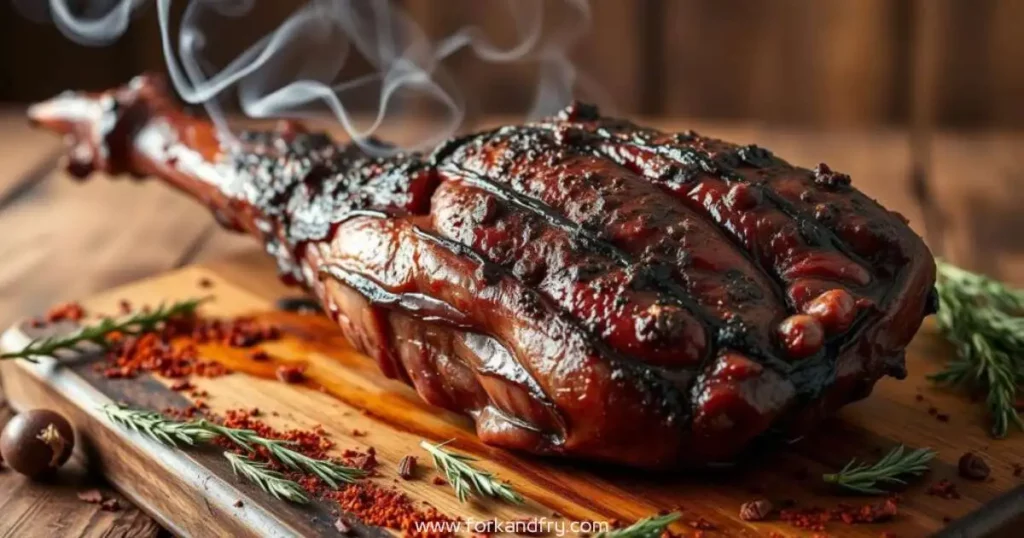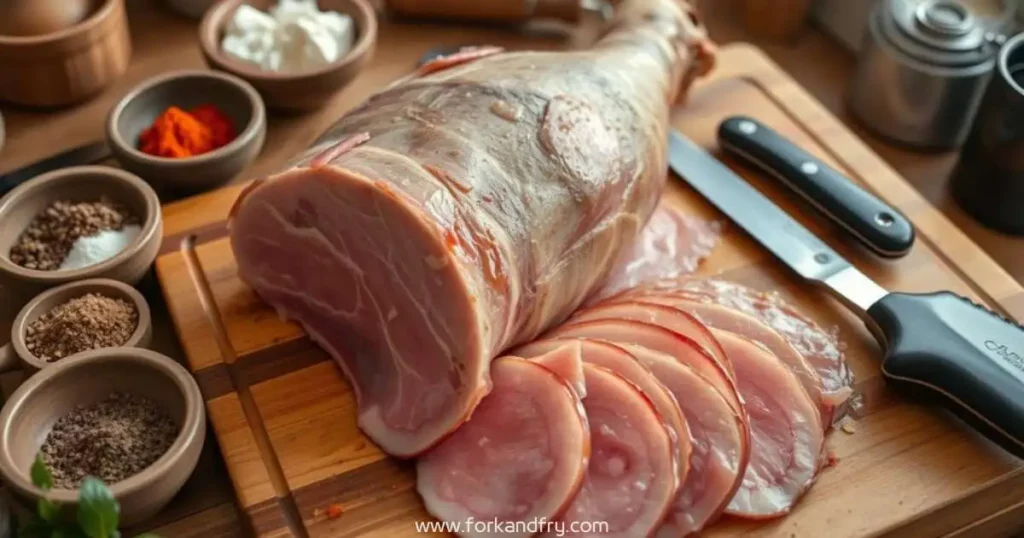Last updated on January 19th, 2025 at 07:25 pm
Table of Contents
Start a culinary journey with smoked deer ham. It’s a rewarding process that brings out the best flavors. Whether you’re experienced or new, you’ll love the rich taste of a deer roast smoked.
Smoke, spice, and more await you. This is the start of your adventure in making smoked venison.

Key Takeaways
- Gain insight into the unique flavor profile of smoked deer ham.
- Learn essential techniques to enhance your smoked deer meat recipes.
- Discover how to select the best cut for your deer roast smoked.
- Master the process of trimming, brining, and smoking deer meat.
- Unveil the secrets of choosing the right woods and spices for smoking.
Understanding the Basics of Smoked Deer Ham
Starting to smoke deer meat is exciting. First, you need to know what it is and why it’s good. We’ll cover what smoked deer ham is, its benefits, and how to pick the best cuts for great taste.
What is Smoked Deer Ham?
Smoked deer ham is the deer’s hindquarter, mainly the shoulder. It’s cured and smoked at low heat. A mix of spices and a brine for deer roast are used to improve its texture and taste. The slow cooking adds a smoky flavor, making it special.
The Benefits of Smoking Deer Meat
Smoking is more than cooking; it’s a way to preserve and add flavor. Smoked deer shoulder, cooked slowly, has a wonderful smell and taste. It makes tough cuts tender and keeps the meat fresh longer, so you can enjoy it for weeks.
Selecting the Right Cut for Smoking
Picking the right cut is key for smoking. The shoulder, or deer ham, is the best choice. It has dense muscles that soak up flavors well. Here’s a quick guide to the best cuts for smoking, including the popular smoked deer shoulder:
| Cut | Description | Best Use |
|---|---|---|
| Shoulder (Deer Ham) | Heavily worked muscles, robust flavor | Smoking |
| Backstrap | Tender and lean | Quick cooking methods |
| Ribs | Marbled with fat, flavorful | Slow roasting or grilling |

Preparation: Trimming and Brining Your Deer Ham
Before diving into smoked deer meat recipes, getting your deer ham ready is key. From trimming to brining, each step is vital. It affects the meat’s moisture, taste, and success in deer roast smoked.
The Importance of Trimming Fat and Connective Tissue
Removing excess fat and connective tissues is crucial. It ensures even smoking and better meat texture. Just enough fat is left to keep the meat moist.
Creating the Perfect Brine for Deer Roast
A good brine makes your deer roast tender and flavorful. Salt is a must, but herbs and spices add depth. They enhance the smoky taste.
Brining Time and Techniques
Brining time can vary, but 12 hours is a good start. Injecting brine into the meat helps flavors spread evenly.

Here’s a table with brining ingredients for your deer roast smoked. It shows quantities and their purposes.
| Ingredient | Quantity | Purpose |
|---|---|---|
| Salt | 1 cup | Foundation for dehydration and flavor |
| Brown Sugar | 1/2 cup | Adds sweetness to counteract the salt |
| Garlic Powder | 2 tbsp | Enhances meaty flavors |
| Black Peppercorns | 1 tbsp | Provides a spicy kick |
| Bay Leaves | 3 leaves | Adds aromatic depth |
| Rosemary | 2 sprigs | An herbaceous uplift |
By carefully following these steps, you’re on your way to a delicious, tender deer ham. It’s a feast for the senses.
The Smoking Process: Step-by-Step Guide
Smoking deer meat turns a simple cut into a delicious feast. Whether you’re smoking deer shoulder or ham, it’s an art that needs precision and patience. Here are the steps and tips to make sure your meat turns out great.

- Prepare Your Smoker: Start by making sure your smoker is clean and working well. Heat it up to 225°F, the perfect temperature for tender deer meat.
- Place the Meat: When your smoker is hot, put your deer ham or shoulder on the rack. Place it in the middle so smoke can get all around it.
- Monitor the Smoke: Keeping the smoke steady is important. Use hardwoods like hickory or oak for flavor without overpowering the meat. Check often to make sure the wood is smoldering, not burning.
- Regulate the Temperature: Keeping the temperature the same is crucial. A digital meat thermometer helps you check the meat’s internal temperature without opening the smoker too much.
- Maintain Moisture: To keep the meat moist, add a water pan to your smoker. It helps keep the humidity and temperature right.
- Check for Doneness: After a few hours, check the meat’s internal temperature. Deer should be cooked to 165°F for safety, but you can cook it a bit longer for extra tenderness.
- Rest Before Serving: When the meat is cooked, take it out of the smoker and let it rest for 20 minutes. This makes sure the juices spread evenly, making every slice juicy and flavorful.
By following these steps, you’ll get a perfectly smoked deer shoulder or ham. It’s not just cooking; it’s a craft that makes your meat richly flavored and tender.
Flavor Profiles: Choosing Woods and Spices
Choosing the right wood and spices is key to enhancing your smoked deer ham‘s flavor. The wood you pick greatly affects the smoky taste. The right spices can also bring out the deer meat’s unique flavor.
Determining the Best Wood for Smoking Deer Ham
The wood you choose is vital for smoking. It’s the main source of smoky flavor in your deer ham. Hickory, apple, and cherry woods are favorites. They add a mild to strong smokiness without hiding the meat’s natural taste.
Combining Herbs and Spices for Your Deer Roast
When making the perfect brine for deer roast, think about adding spices like juniper berries, garlic powder, and rosemary. These spices not only boost the meat’s flavor but also help keep it tender and moist.
Marinades vs. Dry Rubs: Enhancing the Smoked Flavor
Marinades and dry rubs offer different flavor experiences. Marinades give a moist, infused taste that deeply penetrates the meat. Dry rubs, on the other hand, create a crisp, flavorful crust that keeps the meat juicy.
| Wood Type | Flavor Profile | Best Pairing with Spices |
|---|---|---|
| Hickory | Strong, bacon-like | Garlic, Onion, Bay Leaves |
| Apple | Mild, sweet | Cinnamon, Clove, Allspice |
| Cherry | Mild, fruity | Pepper, Rosemary, Thyme |
When picking your flavorings, think about how they’ll work with your wood choice. The right woods and spices can make your smoked deer ham truly special. Each bite will be unforgettable.
Monitoring Your Smoked Deer Ham
Mastering the art of smoking deer ham requires careful control and constant attention. Whether you’re making smoked deer shoulder, deer roast smoked, or trying other recipes, knowing about temperature and smoke is key. Here’s how to make sure every piece of meat is perfectly smoked, safe, and full of flavor.
Understanding Internal Temperature
To get the perfect tenderness and ensure your smoked deer meat is safe, watch the internal temperature closely. The target temperature for smoked deer shoulder and other cuts should be at least 145°F. This not only ensures safety but also makes sure your deer roast is moist and flavorful.
Using a Meat Thermometer
A good meat thermometer can make a big difference in your smoking success. Insert the thermometer into the thickest section of the meat, ensuring it doesn’t touch any bone or fat for a precise reading. Regular checks help keep the right temperature without letting heat out and making cooking take longer.
Tips for Maintaining Consistent Smoke
Keeping a steady smoke flow is crucial for that rich, smoky flavor in your smoked deer meat recipes. Here are some tips:
- Choose quality wood chips or chunks for consistent smoke. Avoid green or moist wood that can make too much smoke and ruin the flavor.
- Adjust your smoker’s air vents; slightly open vents increase temperature and smoke flow. Closed vents can smother the fire and reduce smoke.
- Try to keep the smoker door closed as much as possible to keep a stable temperature and smoke level.
Smoked Deer Meat Recipes: From Traditional to Innovative
Discover the deep flavors of the wild with these tasty recipes. They transform your smoked deer meat into something truly special. Whether you’re an expert chef or just starting, these recipes will encourage you to try new things. Enjoy the delicious world of deer roast smoked.
Classic Smoked Deer Shoulder Recipe
Start with a brined deer roast for this classic dish. It’s all about keeping it simple to let the meat’s natural taste stand out. First, make a brine with salt, sugar, and herbs. Then, slow smoke the meat to add a subtle smokiness.
Infusing International Flavors into Smoked Deer Meat
Try adding bold international flavors to your deer roast. Marinate it in soy sauce, garlic, ginger, and scallions for an Asian twist. Or, use a Moroccan rub with smoked paprika, cumin, and coriander. Each flavor adds a unique taste that will wow your guests.
Serving Suggestions and Pairings
Pair your smoked deer meat with sides that complement it. Try a tangy coleslaw or a warm baked potato. For wine lovers, a full-bodied red like Shiraz or Merlot is perfect. It brings out the rich flavors of the deer roast.
Conclusion
Starting your journey to make smoked deer ham has shown you the key steps and tasty secrets. This guide has just scratched the surface of what you can do with patience and a love for the flavors of smoking. You now know how to improve your cooking skills with game meats.
Exploring different woods and spices has taught you how to change flavors in your smoked deer ham. By paying close attention to your cooking, you can make meals that feel like a trip to the outdoors. Every step, from preparing the meat to enjoying the last bite, is a reward for making something yourself.
We hope you’ll keep improving your smoking skills. Whether you stick to traditional flavors or try new ones, remember it’s about creating a special meal. So, get your smoker ready, gather your ingredients, and let the magic of smoke transform your game meats into something amazing.
FAQ
What is Smoked Deer Ham?
Smoked deer ham is the hind leg of a deer, cured and smoked. This process adds a rich flavor. It’s a favorite among those who love game meat.
Why is smoking deer meat beneficial?
Smoking deer meat keeps it fresh longer and adds a smoky taste. It also makes the meat tender. This traditional method brings a new flavor to deer meat.
How do I select the right cut of deer for smoking?
Choose deer shoulders, hams, or roasts for smoking. These cuts have the right mix of meat and fat. They stay juicy and flavorful during the smoking process.
Why is trimming fat and connective tissue important before smoking deer ham?
Trimming fat and connective tissue ensures even smoking. It prevents tough meat. This lets the smoke penetrate better, enhancing flavor and texture.
How do I create the perfect brine for a deer roast?
Mix salt, sugar, and seasonings in water to make the brine. Balance the taste. Add garlic, onions, or herbs for extra flavor.
What is the recommended brining time for deer ham?
Brine deer ham for 12 to 24 hours, depending on size and taste. This time lets the meat absorb flavor without becoming too salty.
Can you provide a step-by-step guide for smoking deer shoulder?
Start by selecting the right cut and trimming it. Then, brine and season it. Smoke it at a steady temperature until it’s fully cooked. Rely on a meat thermometer to monitor the temperature.
What is the best wood for smoking deer ham?
Hickory, apple, oak, or cherry wood are great for smoking deer ham. They add a strong but balanced smoky flavor. The right wood enhances the deer’s gamey taste.
Should I use marinades or dry rubs for smoking deer meat?
Marinades tenderize and add moisture, while dry rubs create a crusty bark. Choose based on your flavor and moisture preferences.
How do I know when my smoked deer ham is fully cooked?
Deer ham is cooked when it reaches 145°F (62.8°C). Always check with a meat thermometer to ensure it’s safe and tasty.
What are some tips for maintaining consistent smoke when smoking deer?
Keep the fire steady with wood chips or chunks. Control airflow for a stable temperature. Minimize opening the smoker frequently to maintain consistent smoke levels.
Could you suggest a classic smoked deer shoulder recipe?
Brine the meat, season it, and smoke it over your preferred wood. Rest the meat before slicing for the best flavor and juiciness.
How can I incorporate international flavors into smoked deer meat?
Try different spices, herbs, and marinades from around the world. For example, use cumin and chili powder for a Mexican flavor or soy for an Asian twist. Deer meat pairs well with many international flavors.
What are some serving suggestions and pairings for smoked deer meat?
Serve smoked deer with roasted veggies, mashed potatoes, or a salad. Pair it with red wine, ale, or whiskey. Try it with a fruit sauce or chutney for a sweet contrast.





